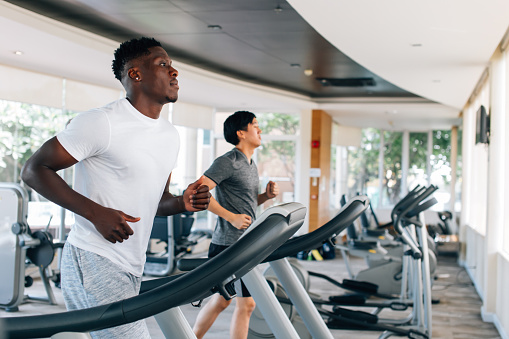
The weather is changing, temperatures are becoming cooler, and the daylight is not lasting as long. It is the time of year that a lot of workout routines start to suffer as a result. For those who continue with their workouts, they either layer up their clothing or they move to indoor workouts. There are a portion of people who would like to move their runs to a treadmill, but cannot because of vertigo or dizziness symptoms.
Running or walking on a treadmill can be a confusing task for the brain. Your body is sending messages to the brain indicating that it is moving, but your eyes are sending another message indicating that you are not moving as much as your body is perceiving. In addition to this, there are times when changing your gaze or focus while on the treadmill can be a triggering event.
Even though this can be a confusing task for the brain, it does not have to be! There are a few steps that can be taken to help you avoid triggering your symptoms while you change to your indoor treadmill workouts.
- Find a point of focus. If you are able to focus on a nearby target this can help orient your brain through your visual system. Find a target that is easy to clearly see and that is not too far. You can also use tape and create a target to look at. And, do not forget to avoid rapid head movements.
- If you wear corrective lenses, you want to be sure that they do not move while you are walking/jogging. If your glasses are bouncing your vision is not as clear and this alone can trigger motion sickness like symptoms. If appropriate it may be wise to consider using contacts for these workouts. Or, you can use a strap to secure your glasses, or consider prescription-based sporting eyewear.
- Start slow. Yes, you may be able to run a mile at 7.0 mph, but don’t try to start off at that speed. Start by doing a walk or slower jog to allow your body to gradually adjust. You may be able to increase the speed during the same session, or you may have to work your way up over the next few sessions.
- If your symptoms start to occur, decrease the activity intensity and take it back down to a level where you feel the symptoms subside. In some cases, you may need to gradually decrease to a full stop. Don’t try to push your body past this point as it can result in you becoming even more symptomatic and lead to injury while using the treadmill. If your symptoms resolve quickly you may be able to re-engage in the activity; however, never compromise your safety to complete a workout. You may need to tell your ego to take a backseat and stop to ensure you do not hurt yourself.
- Ask a vestibular specialist for help! I cannot reiterate enough the importance of vestibular rehabilitation. It is vital that your treatment be tailored towards the activities that you enjoy, and that the various balance symptoms be screened to allow for any noted deficits to be addressed. A specially trained physical therapist can prescribe a therapy plan that includes various exercises for your eyes, brain, and functional specific movements to directly address your needs and help you get back to doing what you enjoy.
So, before you hang up the running or walking shoes during the cooler months, give some of these tips a try. I would personally recommend starting with the last tip to make sure that your safety is the highest priority.
Have questions about what exercises may increase your symptoms? Send us a message on Instagram @reignpt.wellness or leave a comment below.
